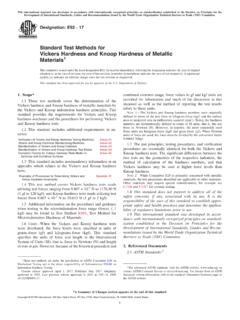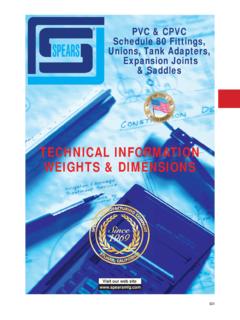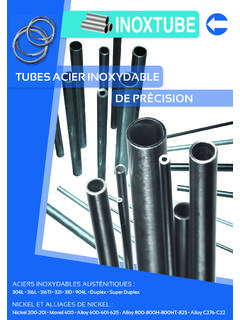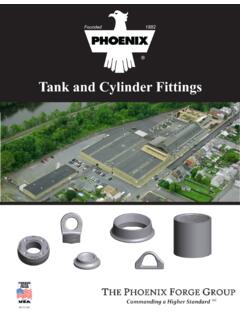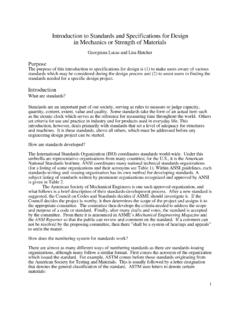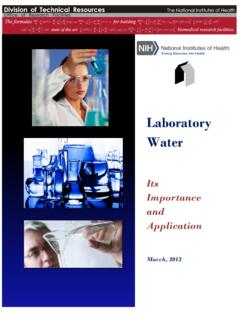Transcription of Standard Test Methods for Rockwell Hardness of Metallic ...
1 Designation: E18 17 1An American National StandardStandard Test Methods forRockwell Hardness of Metallic Materials1,2 This Standard is issued under the fixed designation E18; the number immediately following the designation indicates the year of originaladoption or, in the case of revision, the year of last revision. A number in parentheses indicates the year of last reapproval. A superscriptepsilon ( ) indicates an editorial change since the last revision or Standard has been approved for use by agencies of the Department of Defense. 1 NOTE editorially corrected in August Scope* These test Methods cover the determination of theRockwell Hardness and the Rockwell superficial Hardness ofmetallic materials by the Rockwell indentation Hardness prin-ciple. This Standard provides the requirements for Rockwellhardness machines and the procedures for performing Rock-well Hardness This Standard includes additional requirements in an-nexes.
2 Verification of Rockwell Hardness Testing MachinesAnnex A1 Rockwell Hardness Standardizing MachinesAnnex A2 Standardization of Rockwell IndentersAnnex A3 Standardization of Rockwell Hardness Test BlocksAnnex A4 Guidelines for Determining the Minimum Thickness of aTest PieceAnnex A5 Hardness Value Corrections When Testing on ConvexCylindrical SurfacesAnnex This Standard includes nonmandatory information inappendixes which relates to the Rockwell Hardness of astm Standards Giving Hardness ValuesCorrespondingto Tensile StrengthAppendix X1 Examples of Procedures for Determining RockwellHardness UncertaintyAppendix At the time the Rockwell Hardness test wasdeveloped, the force levels were specified in units ofkilograms-force (kgf) and the indenter ball diameters werespecified in units of inches (in.). This Standard specifies theunits of force and length in the International System of Units(SI); that is, force in Newtons (N) and length in millimeters(mm).
3 However, because of the historical precedent andcontinued common usage, force values in kgf units and balldiameters in inch units are provided for information and muchof the discussion in this Standard refers to these The test principles, testing procedures, and verificationprocedures are essentially identical for both the Rockwell andRockwell superficial Hardness tests. The significant differencesbetween the two tests are that the test forces are smaller for theRockwell superficial test than for the Rockwell test. The sametype and size indenters may be used for either test, dependingon the scale being employed. Accordingly, throughout thisstandard, the term Rockwell will imply both Rockwell andRockwell superficial unless stated Standard does not purport to address all of thesafety concerns, if any, associated with its use. It is theresponsibility of the user of this Standard to establish appro-priate safety and health practices and determine the applica-bility of regulatory limitations prior to international Standard was developed in accor-dance with internationally recognized principles on Standard -ization established in the Decision on Principles for theDevelopment of International Standards, Guides and Recom-mendations issued by the World Trade Organization TechnicalBarriers to Trade (TBT) Referenced Standards.
4 3A370 Test Methods and Definitions for Mechanical Testingof Steel ProductsA623 Specification for Tin Mill Products, General Require-mentsA623 MSpecification for Tin Mill Products, General Re-quirements [Metric]B19 Specification for Cartridge Brass Sheet, Strip, Plate,Bar, and DisksB36/B36 MSpecification for Brass Plate, Sheet, Strip, AndRolled BarB96/B96 MSpecification for Copper-Silicon Alloy Plate,Sheet, Strip, and Rolled Bar for General Purposes andPressure Vessels1 These test Methods are under the jurisdiction of astm CommitteeE28onMechanical Testing and are the direct responsibility of Hardness edition approved July 1, 2017. Published July 2017. Originally approvedin 1932. Last previous edition approved in 2016 as E18 16. DOI: this test method, the term Rockwell refers to an internationally recognizedtype of indentation Hardness test as defined in Section3, and not to the hardnesstesting equipment of a particular referenced astm standards, visit the astm website, , orcontact astm Customer Service at ForAnnual Book of ASTMS tandardsvolume information, refer to the Standard s Document Summary page onthe astm website.
5 *A Summary of Changes section appears at the end of this standardCopyright astm International, 100 Barr Harbor Drive, PO Box C700, West Conshohocken, PA 19428-2959. United StatesThis international Standard was developed in accordance with internationally recognized principles on standardization established in the Decision on Principles for theDevelopment of International Standards, Guides and Recommendations issued by the World Trade Organization Technical Barriers to Trade (TBT) B103/B103 MSpecification for Phosphor Bronze Plate,Sheet, Strip, and Rolled BarB121/B121 MSpecification for Leaded Brass Plate, Sheet,Strip, and Rolled BarB122/B122 MSpecification for Copper-Nickel-Tin Alloy,Copper-Nickel-Zinc Alloy (Nickel Silver), and Copper-Nickel Alloy Plate, Sheet, Strip, and Rolled BarB130 Specification for Commercial Bronze Strip for BulletJacketsB134/B134 MSpecification for Brass WireB152/B152 MSpecification for Copper Sheet, Strip, Plate,and Rolled BarB370 Specification for Copper Sheet and Strip for BuildingConstructionE29 Practice for Using Significant Digits in Test Data toDetermine Conformance with SpecificationsE92 Test Methods for Vickers Hardness and Knoop Hard-ness of Metallic MaterialsE140 Hardness Conversion Tables for Metals RelationshipAmong Brinell Hardness , Vickers Hardness , RockwellHardness, Superficial Hardness , Knoop Hardness , Sclero-scope Hardness , and Leeb HardnessE384 Test Method for Microindentation Hardness of Mate-rialsE691 Practice for Conducting an Interlaboratory Study toDetermine the Precision of a Test Bearings Manufacturer Association Stan-dard:ABMA 10-1989 Metal Standards.
6 ISO 6508-1 Metallic Materials Rockwell Hardness Test Part 1: Test Method (scales A, B, C, D, E, F, G, H, K, N,T)5 ISO/IEC 17011 Conformity Assessment General Require-ments for Accreditation Bodies Accrediting ConformityAssessment Bodies5 ISO/IEC 17025 General Requirements for the Competenceof Testing and Calibration of Automotive Engineers (SAE) Standard :SAE J417 Hardness Tests and Hardness Number Conver-sions63. Terminology and determination of the values of the sig-nificant parameters by comparison with values indicated by areference instrument or by a set of reference checking or testing to assure confor-mance with the to bring in conformance to a knownstandard through verification or Hardness test an indentation Hardness testusing a verified machine to force a diamond spheroconicalindenter or tungsten carbide (or steel) ball indenter, underspecified conditions, into the surface of the material under test,and to measure the difference in depth of the indentation as theforce on the indenter is increased from a specified preliminarytest force to a specified total test force and then returned to thepreliminary test superficial Hardness test same as the Rock-well Hardness test except that smaller preliminary and total testforces are used with a shorter depth Hardness number a number derived fromthe net increase in the depth of indentation as the force on anindenter is increased from a specified preliminary test force toa specified total test force and then returned to the preliminarytest Hardness machine a machine capable ofperforming a Rockwell Hardness test and/or a Rockwell super-ficial Hardness test and displaying the resulting Rockwellhardness Hardness testing machine a Rockwellhardness machine used for general testing Hardness standardizing machine a Rock-well Hardness machine used for the standardization
7 Of Rock-well Hardness indenters, and for the standardization of Rock-well Hardness test blocks. The standardizing machine differsfrom a regular Rockwell Hardness testing machine by havingtighter tolerances on certain TheaverageH of a set ofnhardness measurementsH1,H2,..,Hnis calculated as:H (1) Theerror Ein the performance of a Rockwell hard-ness machine at each Hardness level, relative to a standardizedscale, is determined as:E5H 2 HSTD(2)where:H = average of n Hardness measurementsH1,H2,..,Hnmade on a standardized test block as part of aperformance verification, andHSTD= certified average Hardness value of the standardizedtest Therepeatability Rin the performance of a Rockwellhardness machine at each Hardness level, under the particularverification conditions, is estimated by the range ofnhardnessmeasurements made on a standardized test block as part of aperformance verification, defined as:R5 Hmax2 Hmin(3)where:Hmax= highest Hardness value, andHmin= lowest Hardness from American Bearing Manufacturers Association (ABMA), 2025M Street, NW, Suite 800, Washington, DC from American National Standards Institute (ANSI), 25 W.
8 43rd St.,4th Floor, New York, NY 10036, from Society of Automotive Engineers (SAE), 400 CommonwealthDr., Warrendale, PA 15096-0001, 17 12 4. Significance and The Rockwell Hardness test is an empirical indentationhardness test that can provide useful information about metallicmaterials. This information may correlate to tensile strength,wear resistance, ductility, and other physical characteristics ofmetallic materials, and may be useful in quality control andselection of Rockwell Hardness tests are considered satisfactory foracceptance testing of commercial shipments, and have beenused extensively in industry for this Rockwell Hardness testing at a specific location on a partmay not represent the physical characteristics of the whole partor end Adherence to this Standard test method provides trace-ability to national Rockwell Hardness standards except as Principles of Test and Hardness Test Principle The general prin-ciple of the Rockwell indentation Hardness test is illustrated inFig.
9 1. The test is divided into three steps of force applicationand 1 The indenter is brought into contact with the testspecimen, and the preliminary test forceF0is applied. Afterholding the preliminary test force for a specified dwell time,the baseline depth of indentation is 2 The force on the indenter is increased at acontrolled rate by the additional test forceF1to achieve thetotal test forceF. The total test force is held for a specifieddwell 3 The additional test force is removed, returning tothe preliminary test force. After holding the preliminary testforce for a specified dwell time, the final depth of indentationis measured. The Rockwell Hardness value is derived from thedifferencehin the final and baseline indentation depths whileunder the preliminary test force. The preliminary test force isremoved and the indenter is removed from the test There are two general classifications of the Rockwelltest: the Rockwell Hardness test and the Rockwell superficialhardness test.
10 The significant difference between the two testclassifications is in the test forces that are used. For theRockwell Hardness test, the preliminary test force is 10 kgf (98N) and the total test forces are 60 kgf (589 N), 100 kgf (981 N),and 150 kgf (1471 N). For the Rockwell superficial hardnesstest, the preliminary test force is 3 kgf (29 N) and the total testforces are 15 kgf (147 N), 30 kgf (294 N), and 45 kgf (441 N). Indenters for the Rockwell Hardness test include adiamond spheroconical indenter and tungsten carbide ballindenters of specified Steel indenter balls may be used only for testing thinsheet tin mill products specified in SpecificationsA623andA623 Musing the HR15T and HR30T scales with a diamondspot anvil. Testing of this product may give significantlydiffering results using a tungsten carbide ball as compared tohistorical test data using a steel Previous editions of this Standard have stated that the steelball was the Standard type of Rockwell indenter ball.

